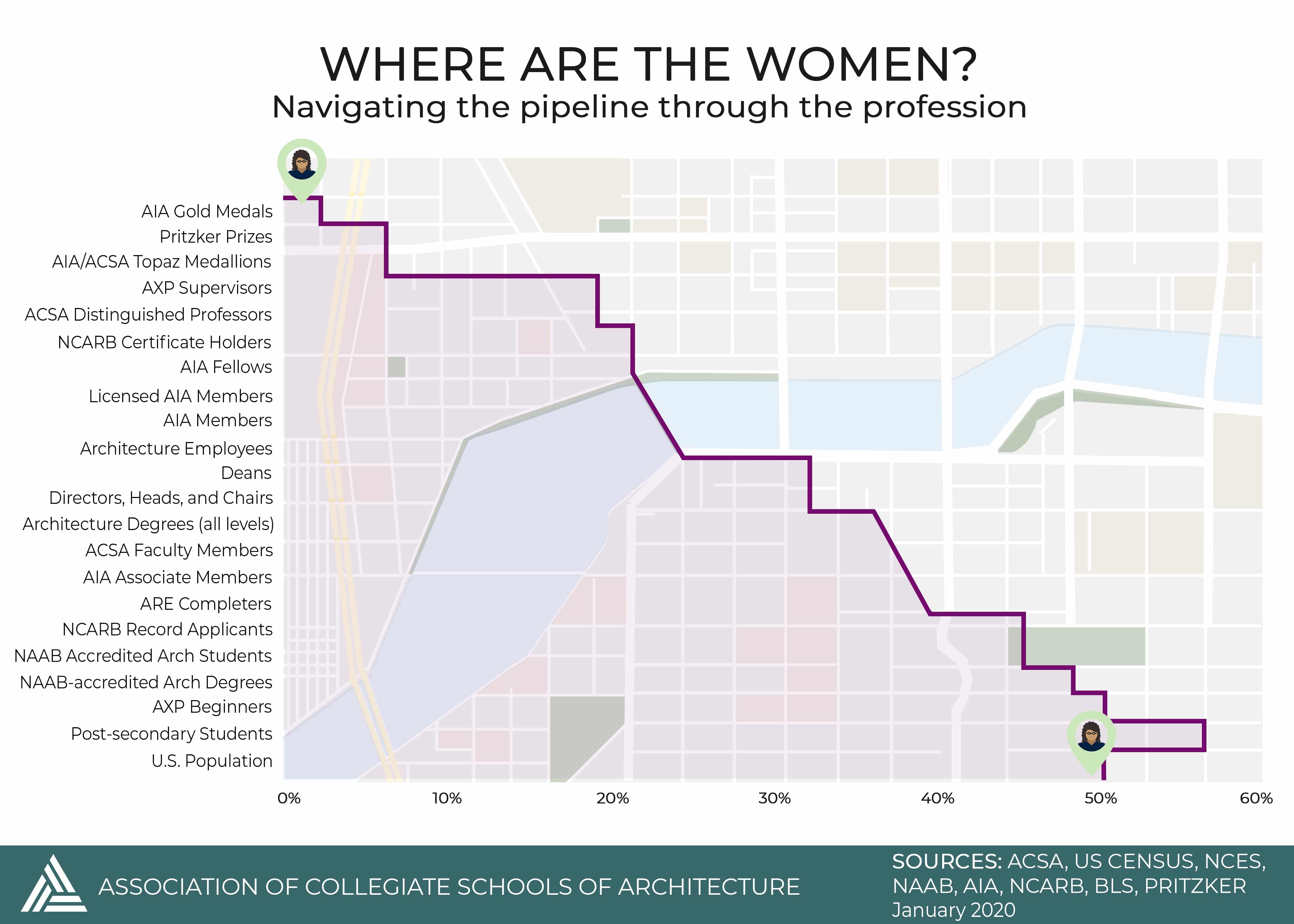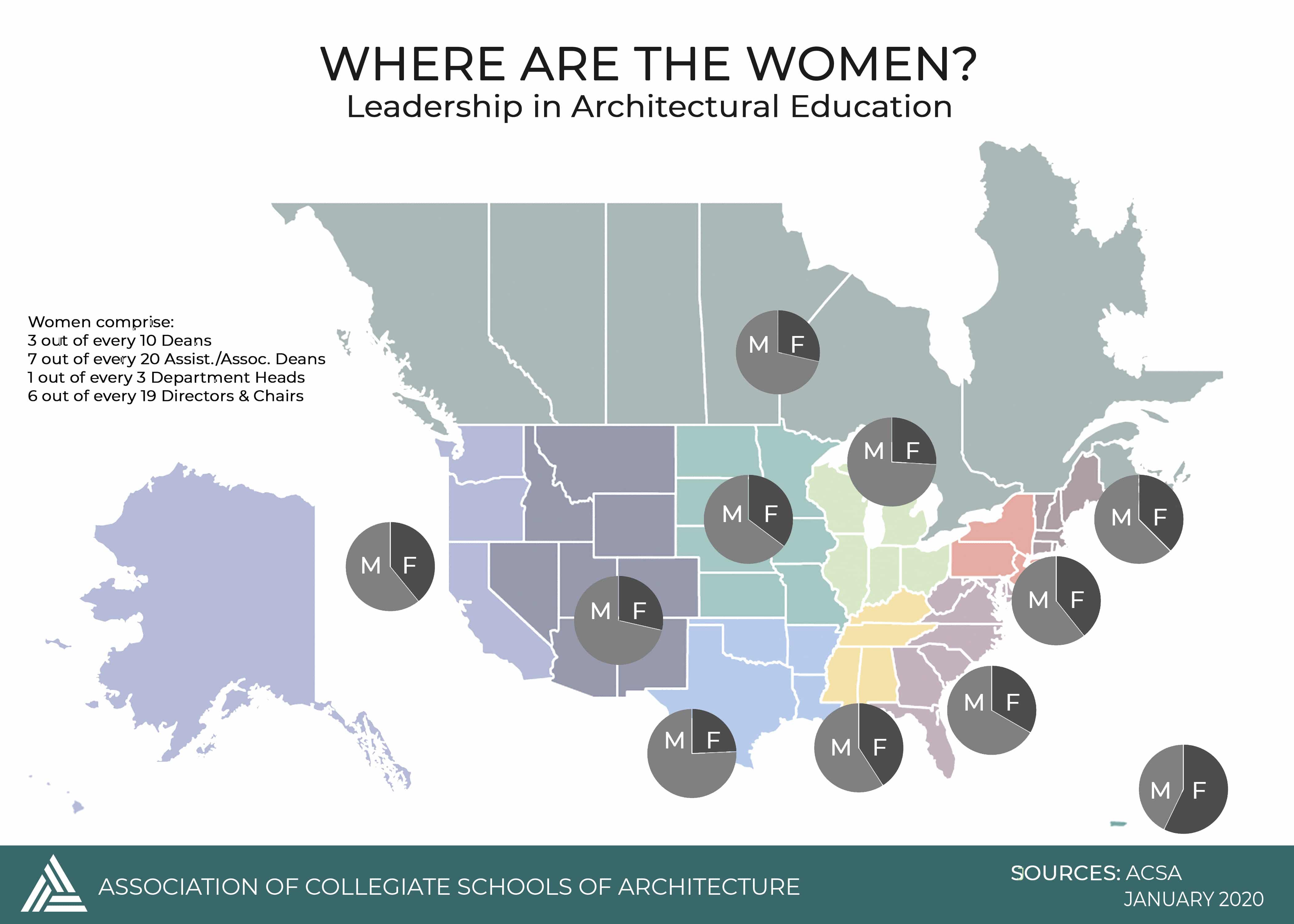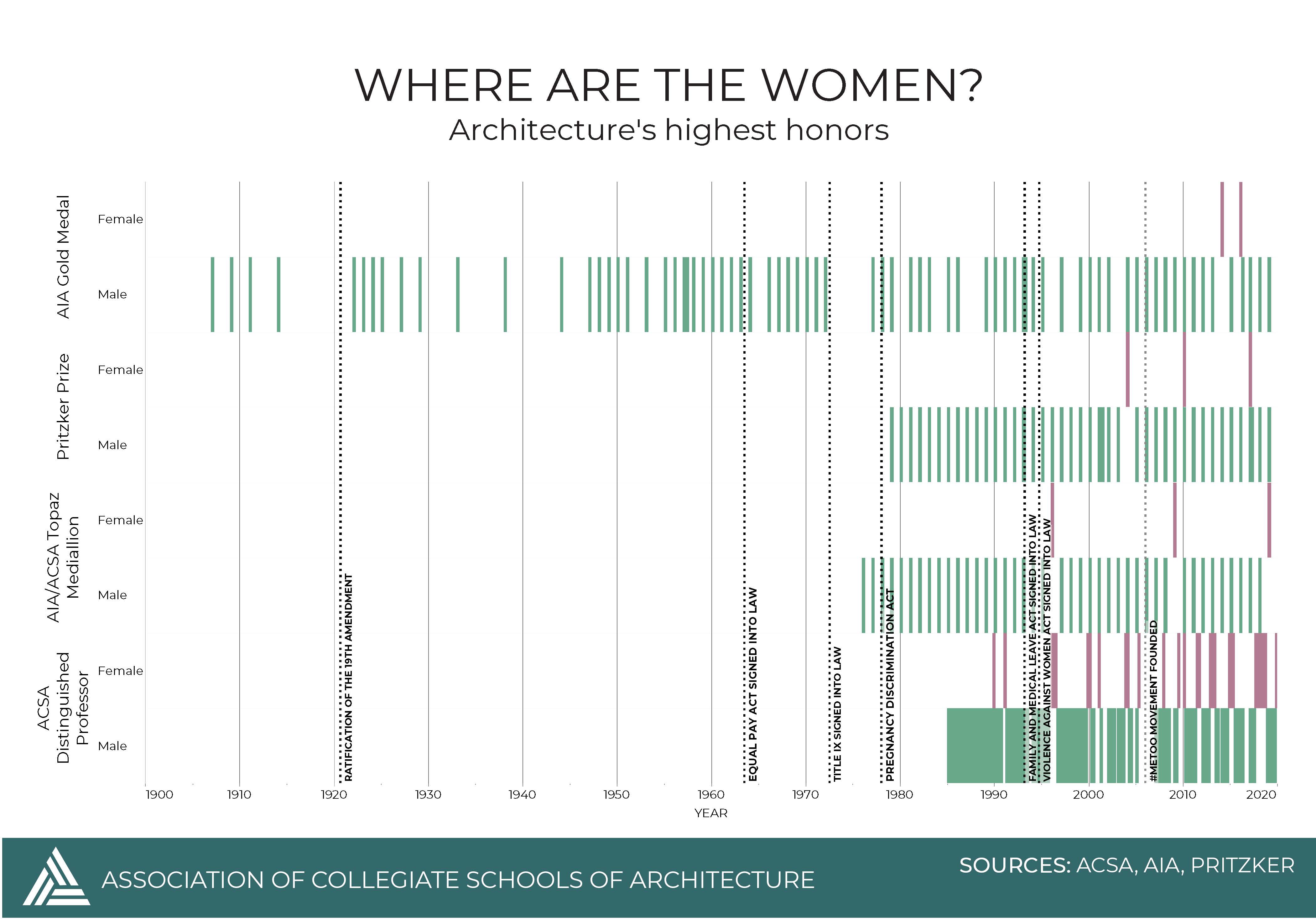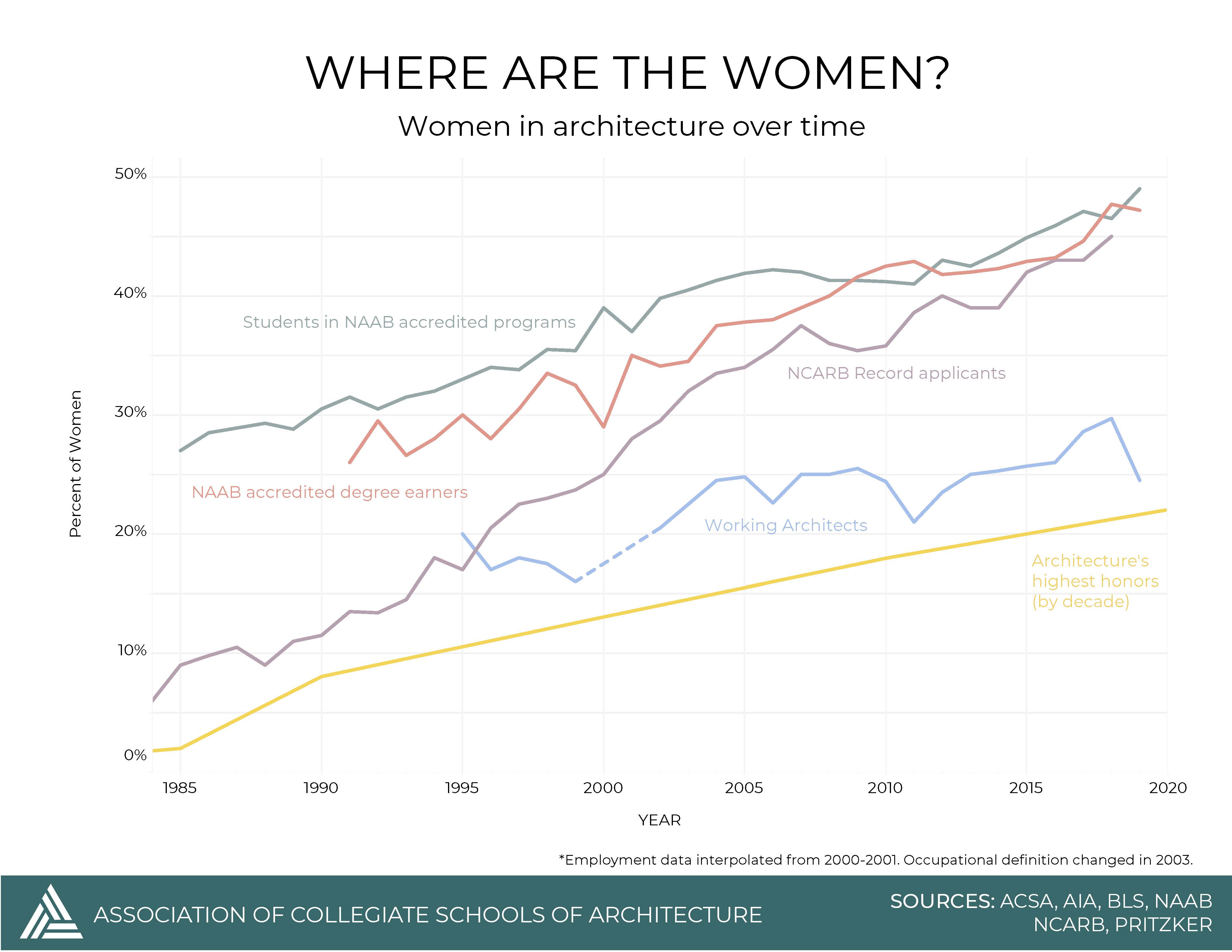How Long Does It Take Ncarb to Review Record


Where Are the Women? Measuring Progress on Gender in Architecture
Kendall A. Nicholson, Ed.D., Assoc. AIA, NOMA, LEED GA
ACSA Director of Enquiry and Data
June 2020
Similar many professions in the Us, architecture has a long-continuing history of being a male person-dominated field. From its inception, the discipline has non been attainable for all people. In 2014, the Association of Collegiate Schools of Architecture (ACSA) investigated the disparities betwixt men and women in the areas of representation, inclusion, and recognition. This 2020 edition of Where Are the Women? updates information highlighting how women make up an equal office of the population merely an diff part of the field of study. The chart shown below calls attention to the path of progress for women in the profession using commonly referenced metrics. It starts with the U.South. population and tops out with the pct of females awarded the AIA Gilded Medal over the history of the accolade. Not all of the metrics provide an "apple to apples" comparing, but each metric gives some reliable indication of how much or how little gender disinterestedness has progressed in recent years.

U.S. Population: The United States Census Bureau reports that in 2019, 51% of the 328 meg estimated people residing in the United States were women.
Post-secondary Students: In 2019, the National Center for Education Statistics (NCES) reported that more than than half (57%) of the students enrolled in college education across the United States identified as female. This means that women make up a larger percentage of students enrolled in higher didactics than in the general population.
AXP Beginners: Aspiring architects log hours of on-the-chore experience in the National Council of Architectural Registration Boards' (NCARB) Architectural Experience programme. In 2018 NCARB reported 50% of those who started in AXP were women, a metric for tracking the demographics of those moving from educational activity toward licensure.
NAAB-accredited Architecture Degrees: The National Architectural Accrediting Board's (NAAB) annual report also shows that in 2017-eighteen academic yr, 48% of the five,995 accredited architecture degrees were awarded to women. Considering a NAAB-accredited caste is a requirement for licensure in most jurisdictions, earning this degree is a clear and measurable moment of the "pipeline" into the profession.
NAAB-accredited Architecture Students: In its 2018 annual report, the National Architectural Accrediting Lath (NAAB) indicates that 46% of the 25,305 students enrolled in NAAB-accredited architecture programs (B.Arch, Chiliad.Arch, and D.Curvation) in 2017-eighteen were female. Over the past 5 years, the representation of women in architecture schools has been steadily increasing.
NCARB Record Applicants: Applying for an NCARB record is a first pace for students or graduates to complete the AXP or the Architect Registration Examination (ARE). In 2018, 45% of NCARB tape applicants were women
ARE Completers: In 2018, 39% of those who completed all six divisions of the Architect Registration Test (ARE) were women, according to NCARB. Successful completion of the ARE is 1 prerequisite for professional licensure and an important part of the architecture pipeline as information technology relates to the profession.
AIA Associate Members: The American Plant of Architects (AIA) indicates that in 2017, 39% of its Associate members were women. This membership category is open to individuals "without [an] architectural license from a United states of america licensing authority who meets other architectural educational or employment requirements prepare out in the Constitute'southward Bylaws." So although this number is an inexact measure out of the "pipeline" through the profession, this voluntary membership is an indication of representation and intention.
ACSA Faculty Members: More than 5,000 blueprint educators teach in ACSA member schools in the United states and Canada. ACSA records indicate that 38% of programme faculty place as women. Reviewing tenure status for professors at tenure-granting institutions revealed a significant departure in men and women's likelihood to be a tenured professor. More than than one-half (55%) of the male person professors at ACSA fellow member schools reported having obtained tenure, while only 40% of women reported being tenured. In regard to areas of expertise, women were more than likely to report research expertise—in lodge from greatest to to the lowest degree—in Interior Architecture, Health & Aging, Materials Inquiry, Participatory Design and Community Date, and Resilience.
Architecture Degrees (all levels): Based on data from the National Heart for Education Statistics (NCES), women received 36% of all architecture degrees awarded in 2018. Whereas the above NAAB data count only the accredited degrees that are generally required for licensure, NCES does not distinguish between NAAB-accredited and not-professional compages degrees and instead counts both. Degrees awarded across all levels from Associate's up to Doctoral degrees evidence varying percents of female enrollment. Acquaintance degree programs were found to have the lowest percent of women enrolled at just 25%.

Directors, Heads, and Chairs: Based on 2019 ACSA data, , 33% of 496 directors, heads, and chairs at U.South. and Canadian ACSA member compages schools were female.
Deans: By ACSA'southward 2019 count, 31% of 110 deans at U.Due south. and Canadian ACSA member architecture schools were female person. This number has increased past 12% in the by v years and shows substantial growth amongst female person leadership in architectural teaching.
Architecture Employees: The Bureau of Labor Statistics (BLS) reports that in 2019, 25% of the 208,000 people working equally "Architects, except naval" in the The states were women. Let'due south unpack this statistic. The BLS counts those who are employed as an builder in any industry in an "architects, except naval" role. This includes those working as architects for the federal government or for developers, but not those employed as craftspeople, university instructors, urban designers, writers and critics, or other roles in which a person may place with architecture while not practicing it in the strict sense. It includes the self-employed and those on leave, simply not those who are unemployed. Chiefly, the BLS does not distinguish between licensed and not-licensed practitioners ("apprentices and trainees"). If we're measuring different points along our pipeline, this metric refers to points that are potentially earlier, during, and after—or fifty-fifty carve up and parallel—to the steps towards licensure described above. By comparing, NCARB reports that there were 113,554 registered architects in the United States in 2017, so the BLS figure of 208,000 counts many aspiring architects who are pursuing licensure, too as those who are not working towards a license.
Moreover, this statistic is made more than significant when compared to the percent of women reported for what architects often use as comparable professions, law and medicine. The BLS reported that 36% of "Lawyers" were women and 41% of "Physicians and surgeons" were women. This puts the imbalance shown between men and women at more than than 10 percentage points below our peer professions.
AIA Members: AIA membership is one of the best metrics for understanding who in the profession is consistently engaged in current practices and thought leadership specific to architecture. Nevertheless, because membership is not complimentary, there are inherent barriers to membership and the rationale for membership changes from year to twelvemonth and from person to person. In 2017, the AIA reported just 21% of their membership identified as women.
Licensed AIA Members: The AIA knows which of its members have a professional person license, and in 2017 they reported that 22% of their licensed members are women.
AIA Fellows: Using some data mining, we estimate that approximately 21% of its AIA Fellows members were women. This membership category is open to AIA members who have demonstrated distinguished contributions to the subject field and take been elevated to the College of Fellows.
NCARB Certificate Holders: NCARB reports that 21% of NCARB certificate holders –a credential assuasive architects to practice in multiple jurisdictions—are women.

ACSA Distinguished Professors: Starting in 1984-85, the ACSA has recognized a handful of living individuals each twelvemonth for their sustained achievements in advancing architectural educational activity through teaching, pattern, scholarship, research, or service. Chosen by a committee based on nominations, 19% (or 29) of 151 recipients over 35 years have been women.
AXP Supervisors: NCARB by the Numbers reports that 19% of AXP Supervisors—firm managers who supervise and review the piece of work of intern architects submitting AXP hours, and who in near cases must be licensed architects—are women.
AIA/ACSA Topaz Medallions: I Topaz Medallion is awarded each yr to a living person who has influenced "a long line of students" over at least a decade primarily spent in Northward American architectural education. Based on nominations and selected by a jury, 7% (or 3) of 44 recipients since 1976 have been women: Denise Scott Chocolate-brown in 1996, Adèle Naudé Santos in 2009, and Toshiko Mori in 2019.
Pritzker Prizes: Known as the "Nobel Prize of architecture," the Pritzker is awarded each twelvemonth to a single living practicing architect (or occasionally a pair) in recognition of meaning contributions to humanity and the built environment through built works of architecture. Decided by a jury, based on nominations solicited from notable people in the field, 7% (or 2) of 39 Pritzker Prize recipients since 1979 have been women. This includes Zaha Hadid in 2004, Kazuyo Sejima in 2010, alongside her male partner Ryue Nishizawa and Carme Pigem in 2017, alongside partners Rafael Aranda and Ramon Vilalta.
AIA Gold Medals: This highest honor that the AIA bestows upon an individual or pair recognizes "a pregnant body of work of lasting influence," based on nominations and reviewed past a jury. Of 75 medals since 1907, ii take been awarded to a women (Julia Morgan, posthumously in 2014 and Denise Scott Brown in 2016 aslope her married man Robert Venturi), representing 3% of the total.

While data in contempo years prove an increment in women beingness awarded architecture's highest honors (AIA Aureate Medal, AIA/ACSA Topaz Medallion, Pritzker Prize, and ACSA Distinguished Professor), information technology's equally of import to understand the context. With the exception of the ACSA Distinguished Professor designation, the highest honors in architecture have at least 20 years of history being male-only awards. This history cannot exist changed and counters women's rights legislation in the United States. In the case of the AIA Gold Medal, the era of male-but recipients lasted 107 years making it the most male dominated and the terminal of the four to be awarded to a woman.
While women were pursuing architectural education in the U.s.a. equally early as 1874—Mary Louisa Folio at the University of Illinois Urbana-Champaign—almost 100 years would pass before many institutions offer full co-teaching and Championship 9 of the Pedagogy Amendments would be signed into constabulary past President Richard Nixon. Title Nine, prohibiting sexism in education, and the preceding Equal Pay Act, prohibiting sex activity-based wage discrimination, were landmark moments in the women'south rights motility. Nonetheless, 50 years later, the effects of this take not led to gender parity in compages and many other disciplines.

The last chart shows metrics for students, graduates, NCARB applicants, architects, and architecture awards for the past 35 years. Starting at the tiptop with the green and red lines, we tin can see that the proportion of women amongst NAAB accredited caste earners has historically trailed the proportion of women among enrolled students. However, over the past ten years these 2 lines have converged. In other words, women are graduating with accredited degrees at approximately the aforementioned rate they're enrolling, indicating that there is no longer either a gender-based achievement gap or pipeline delay inside architecture schoolhouse.
The purple line shows the increasing participation of women among NCARB Tape applicants, based on a chart recently published by NCARB. For case, in 1985 women represented over 25% of architecture students enrolled at NAAB-accredited programs only fewer than ten% of NCARB Record applicants. This is a classic example of what we phone call a leak in the compages "pipeline." If this gap reflected only the pipeline delay, or time that information technology would have for these women to progress to further stages at the same rate as their male peers, we would meet the proportion of female NCARB Record applicants exceed 25% a few years after 1985—non fifteen years subsequently, in 2000.
However, in recent years, NCARB Record applicants have reached 40% and has continued to climb indicating that, by comparison to their male colleagues, female students and graduates are essentially more likely than they were in 1985 to take this step towards licensure.
The bluish line shown above represents those working as architects or unlicensed architectural designers every bit measured past the BLS. While the BLS is cautious most certain analyses based on time series data (in office because they occasionally adjust their occupational definitions), fifty-fifty with a sizable margin of error it is articulate that there are far fewer women in practice than in school. This pipeline leak requires a amend understanding of the lived experiences of women working in the profession. ACSA's partnership with AIA SF Equity past Design in 2016 and 2018 uncovered unequal pay, numerous barriers to piece of work-life balance, and a drinking glass ceiling in job roles and responsibilities as only a few reasons why women leave the profession.
Lastly, the xanthous line at the bottom represents the winners of architecture's highest honors, i.due east., the AIA Gold Medal, Topaz Medallion, Pritzker Prize, and ACSA Distinguished Professor. While the numbers, shown as percent of female recipients per decade, take steadily increased, we take not yet reached gender parity. This lack of gender balance among the near prestigious awards in compages reveals a larger problem with the perception of an builder in order and how the field more than readily ascribes pattern excellence to men.
Although the data prove gains in gender equity, in that location is still much room for comeback. For instance, nosotros see that the longer a woman continues to work in and contribute to compages, the narrower her opportunities become for recognition and community edifice with other women. The research provided to a higher place chronicles the demand for greater representation of women in the subject field. All the same, it is important to notation that this attention to representation and diversity is not the aforementioned as what is required to create an equitable futurity for women across the discipline. This research is only the kickoff of a longer discussion. Not only do nosotros need to attract more women to schools of architecture, simply we need to back up them when they get there, and continue supporting them as they engage the profession throughout their career.
Questions
Kendall Nicholson, Ed.D.
Director of Research + Data
202-785-2324
knicholson@acsa-arch.org
I'1000 new here
Click here to add your own text Click here to add your own text Click here to add together your own text Click here to add your ain text
Source: https://www.acsa-arch.org/resource/where-are-the-women-measuring-progress-on-gender-in-architecture-2/
0 Response to "How Long Does It Take Ncarb to Review Record"
Post a Comment